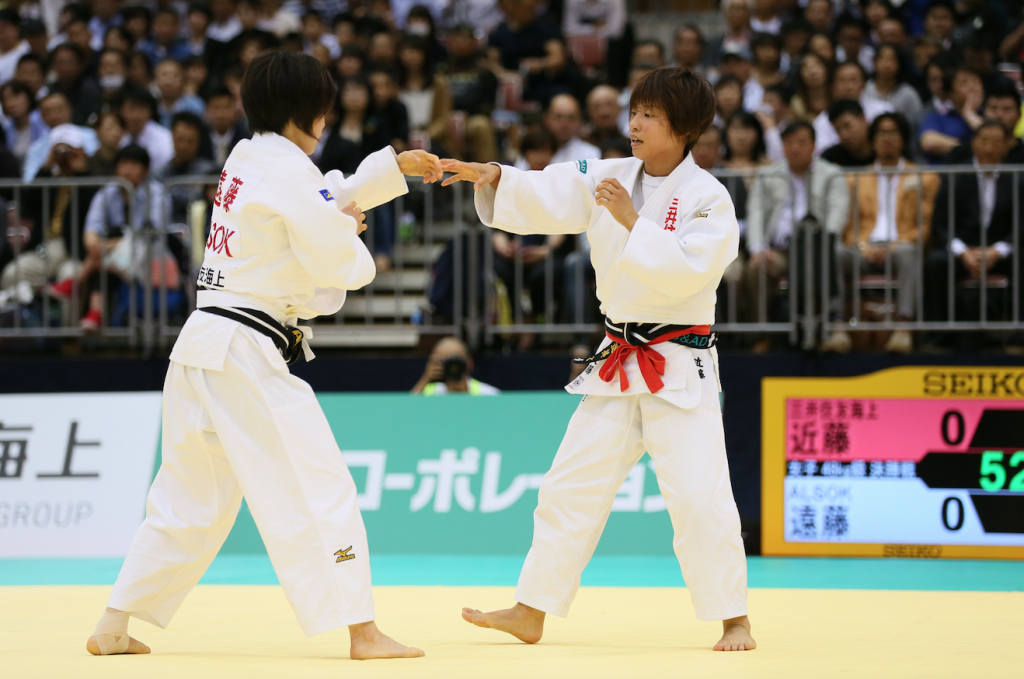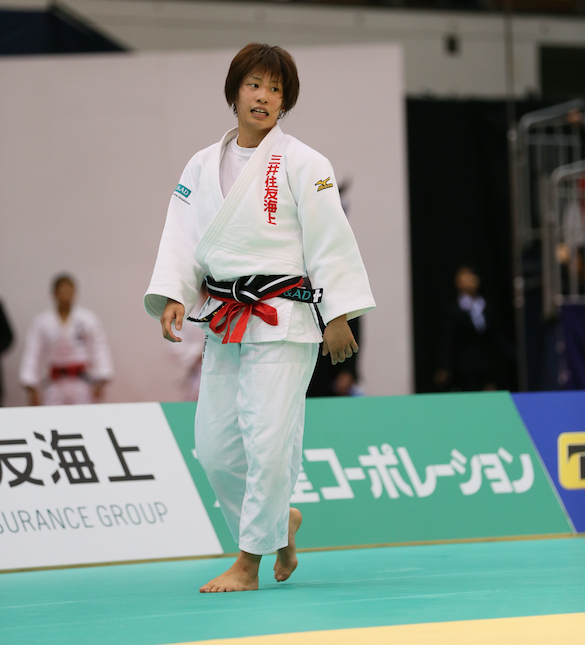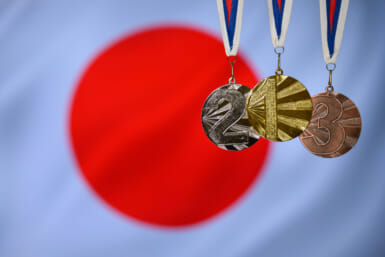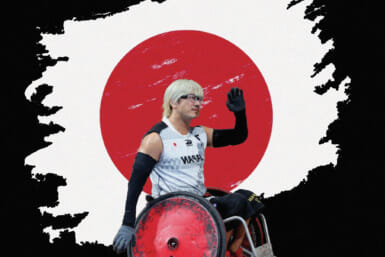Daughter of a sumo wrestler and already a world champion judoka, 21-year-old Ami Kondo carries the weight of expectations with grace and pride.
Interview translated by Honami Iizuka
It was described by the Japanese media as a national disgrace. The country that had invented and for decades dominated the sport of judo was coming home from the 2012 London Olympics with just one gold medal: three fewer than in 2008 and seven fewer than in 2004.
For the All Japan Judo Federation (AFFJ) – who’ve had to deal with far bigger problems since, including abuse and sexual harassment claims – the all-round performance in London was very disappointing. But as they prepare for Rio, there is good reason to feel positive. Japan amassed 13 golds in the last two world championships – eight more than closest rivals France – and the squad assembled for this summer’s Games looks very good on paper with 14 representatives who all have the potential to challenge for medals.
The youngest member of the team is the exciting 21-year-old Ami Kondo. A world champion during her teens, she’ll be competing in the -48 kg category, the same weight division in which legendary figure Ryoko Tani won five medals. So with Rio just over a month away, is Kondo feeling any extra pressure as she prepares to follow in the footsteps of the lady widely regarded as greatest female judoka ever? Weekender recently met up with her at the Ajinomoto National Training Center in Tokyo to find out.
“I don’t think it matters what weight class you’re in; there will always be high expectations placed on the shoulders of Japanese judoka because of our history,” she tells us. “Personally I think it’s a good thing. It gives you that motivation to get to the next level and to win a gold at the Olympics – which is of course my aim – that is what you need.”
Soft-spoken and humble in demeanor, yet a warrior at heart, Kondo has been involved in various sports since she was old enough to walk. During her childhood she would do light physical training with her 100 kg sumo wrestler father on a daily basis. She also participated in a number of artistic gymnastic competitions, but then at the age of five switched her focus to judo.
“It was the sport my brother was doing at the time and he won this gold medal that I really wanted,” she says. “He basically told me, ‘If you want it that badly, go and win your own,’ so that’s why I took up judo. However, I soon realized that getting the top prize isn’t so easy. I’d often finish runner-up and at one event I was so disappointed I locked myself in the bathroom rather than go to the award ceremony. I was eventually coaxed out just in time by my parents and coach.”
Kondo may not have won every tournament she entered, but it was clear from a young age how talented she is. The Nagoya native began to realize her true potential after joining the renowned Oishi Dojo in her second year at elementary school. It was the same studio that two-time Olympic champion Ayumi Tanimoto attended. “Watching Tanimoto win [her second] gold medal in 2008 with a ripping uchi-mata attack was one of my first Olympic memories,” Kondo says. “There are lots of panels at the dojo showing that scene. It was a special moment from a true great who’s had big influence on my career.”
Kondo is now aiming to create her own special scene in Rio so she can join Tanimoto on the wall. Her form over the past few years suggests she has a good chance. Since 2013 she has won a world title, a world junior title, three grand slams and earlier this year a World Masters. Despite achieving much of her success abroad, some have bizarrely suggested that she doesn’t travel well. The recent victory at the Masters in Mexico – where she defeated current Olympic champion Sarah Menezes in the final – was the perfect way to answer the critics. The performance even earned her praise from her notoriously hard-to-please coach Masae Ueno.
“That was a pleasant surprise,” Kondo says, smiling. “Ueno-san never usually compliments me so to get a ‘well done’ from her was a boost. She’s a real hard taskmaster. Even when I think I’ve given everything, she pushes me to go that extra mile. The tough-love approach has helped me a lot.”
Ueno knows what it takes to win at the Olympics. Competing in the -70 kg division, she claimed two golds at the 2004 and 2008 Games. The 37-year-old brought the medals in to training to show Kondo and now the young pupil is aiming to win one for herself. It certainly won’t be easy. The -48 kg category could be one of the most closely contested competitions in Rio. Names to look out for include home favorite Sarah Menezes, current world title holder Paula Pareto, Korea’s Jeong Bo Kyeong, and Mönkhbatyn Urantsetseg from Mongolia. All of them, though, will be wary of the threat that Kondo poses.
“This will be my first Olympics so of course there’s going to be nerves, particularly in the preliminary rounds,” she says. “I just hope I can do myself justice. Getting this far required hard work and sacrifice. One of the toughest things for me has been going without white rice, which I absolutely love. It’s obviously really important to stay under 48 kg so I have to weigh everything I eat. It can be a bit tiresome, but it’ll certainly be worth it if I do manage to get that gold medal around my neck.”
A Short History of Judo
Founded in the late 19th century by Japanese polymath Kano Jigoro, judo was originally created as a physical, moral and mental pedagogy. It evolved into a combat sport and debuted at the 1964 Games in Tokyo. Women judoka did not officially start competing until 1992.
Unsurprisingly, Japan has led the way in the medal table with 70 in total (34 golds). One of the most sensational victories came in 1984 when Yasuhiro Yamashita, on his way to a 203-bout winning streak, took home the gold. He missed out four years earlier because Japan boycotted the Moscow Games, and his hopes in LA seemed to have been dashed when he tore his calf muscle. Still, he reached the final – and won – despite Laurent Del Colombo attacking his injury in the semis. Japan’s most successful Olympic judoka is Tadahiro Nomura who won three golds in a row between 1996 and 2004. In the women’s event, Ryoko Tani is the most decorated Olympian. She made the podium five times in succession, winning two golds.
The 2012 Games proved to be Japan’s worst in the sport with only Kaori Matsumoto (57 kg) emerging victorious. She’ll be in Rio to defend her title alongside Ami Kondo and 12 other judoka.
Know the Throws
There are any many types of 技 (waza, techniques) in judo, including 67 投げ技 (nage-waza, throwing techniques). At the 2012 Olympics 内 股 (uchi-mata, an inner-thigh throw) was the top scoring technique for women, while for the men it was the 双手背負投 (morote-seoi-nage, two-handed shoulder throw). Ami Kondo’s favorite is the 払腰 (harai-goshi, sweeping hip throw). If an 一本 (ippon, one point) is scored, the match is over. Two 技あり (waza-ari, half points) can also decide the contest.
This article appears in the July issue of Tokyo Weekender magazine.










